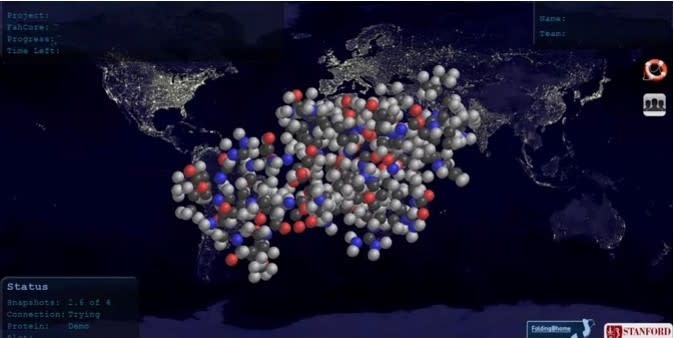MNTC Program a Part of Global Search for COVID-19 Cure

MNTC Program a Part of Global Search for COVID-19 Cure
Moore Norman Technology Center's Virtual Network Administration Instructor Tommy Hamilton learned of Stanford University’s Folding@home project in 2014 while looking for a way to have his students learn about networking and social issues at the same time. Today the computers in his networking lab work in a global race to find a cure for COVID-19.
Until recently, 64 of his program’s computers were used during off-hours to generate close to 50 million points per day in a simulated, distributed-computing search for a cure for Alzheimer’s. When the new coronavirus hit, Hamilton wasted no time changing the goal of his systems’ search.
Stanford University started the distributed-computing project focused on protein folding called Folding@home. They provide free software to individuals or teams with the hope of producing enough folding simulations to aid their researchers in seeking cures for cancers and diseases like Alzheimer’s, Brittle Bone Disease, Parkinson’s and Huntington’s.
Stanford’s focus shifted to COVID-19 research this spring. The software they provide is through their Pande Lab, where Dr. Vijay Pande is the lead researcher.
Folding refers to the way human proteins fold into specific shapes in order to perform various life functions. Humans rely on proteins to remain healthy and fight disease, so when proteins misfold, there can be serious health consequences. Human proteins fold in milliseconds or seconds and although a supercomputer can keep-up with the biological rate of folding by creating simulations for research, it still cannot provide the amount of simulations that a global effort of computers can produce in a search for the cure.
It turns out that COVID-19 also has proteins, making it possible to simulate folding for research. According to the website foldingathome.org/covid19, “Viruses also have proteins that they use to suppress our immune systems and reproduce themselves. To help tackle coronavirus, we want to understand how these viral proteins work and how we can design therapeutics to stop them.”
Hamilton said there are about 250,000 teams and 1.5 million people working toward this unified goal. MNTC’s team, folding@mntc, is currently in 58th place in folding credit with teams representing Ireland, Ukraine, Vietnam, Reddit, Google, Hewlett Packard and more. He and some of his students also run the software on their home computer systems.
Hamilton said a site called Extreme Overclocking sorts the raw data from the project, charts projections and daily status updates and tabulates data every three hours. It calculates trend lines of production and calculates the time in which a team will overtake another team. It tracks the number of computers on any team and alerts when one has a problem.
“With the Alzheimer’s folding project, the raw number data comes in and the local machine runs a simulation based on the data. This simulation builds a virtual model of what researchers want to find out. Once this work unit is complete, it is returned to the project for analysis,” Hamilton said.
“For COVID-19 the approach is the same except they take all they know about the virus and build simulations to see how chemicals react with it. In some cases, they are using the simulation to target the weaknesses of the virus itself.”
He said his job as an instructor is not just to prepare students to join the workforce with a technical skill set, but to also prepare them to become involved within their communities and the world around them. His initial involvement with the Folding@home project began as an effort to do something positive as his late grandmother battled Alzheimer’s. More recently, in 2018 his father was diagnosed with the same disease just before his National Guard unit was mobilized to Kuwait. He has served as a Staff Sergeant in the Oklahoma National Guard for 25 years.
“When we first started, we had 12 computers barely making a few thousand points a day. Today we generate approximately 50 million points per day and it translates to credit for completing work units.
“We have been blessed with great support from MNTC’s administration. These computers serve two purposes: They are primarily tools of education to promote and facilitate learning, but in the off-hours, they serve as powerful research tools to help in this global search,” Hamilton said.
“My students are as much involved in the project as the computers are. I give in-class credit for leadership and special projects. Moore Norman and our students win by being part of a national research project and get to give back to the community. Research wins because we all benefit from the outcomes.”
Learn how to get involved in the Folding@home project or download the software to begin folding at: foldingathome.org/covid19
For more information about MNTC’s Cloud & Virtual Network Administration career program visit mntc.edu.
Moore Norman Technology Center was established in 1972 in Norman, Okla., and is one of 29 technology centers in Oklahoma’s CareerTech system (okcareertech.org). MNTC offers over 30 full-time career programs to high school juniors and seniors from Norman and Moore Public Schools and to adult students in the industry areas of Health, Technical, Business Information Technology, and STEM. MNTC also provides business and industry support, small business management guidance and hundreds of part-time classes with certification pathways in IT, real estate, CLEET, the medical industry and more.
Additional Info
Media Contact : anna.aguilar@mntc.edu
